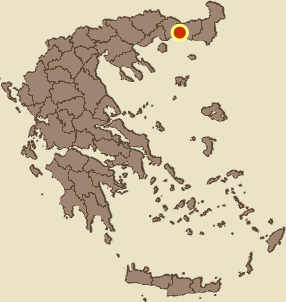Porto Lagos, Iasmos, Rhodope,East Macedonia & Thrace
Castle of Peritheorio
| Location: |
| Southeast of Amaxades, near Porto Lagos, Thrace, North Greece |
| Region > Prefecture: |  |
| East Macedonia & Thrace Rhodope | |
| Municipality > Town: | |
| City of Iasmos • Porto Lagos | |
| Altitude: | |
| Zero Altitude |
| Time of Construction | Origin | |
| 6th century | Late-BYZANTINE |
|
| Castle Type | Condition | |
| Byzantine City |
Rather Poor
|
An important Byzantine fortified city. Big towers and imposing ruins are preserved today hidden by dense vegetation.
Location & Strategic Scope
Anastasioupolis is located near the north shore of Lake Vistonida, on the fertile plain at the foot of the Rhodope Mountains. From Roman times it was a staging post on the Via Egnatia known as Stabulo Diomedis (=Diomedes’ Stables); tradition held it to be the pastures of the wild and man-eating horses of Diomedes, which only Hercules managed to capture.
The city was also an important port at a time that the lake was connected to the sea. Nowadays, the ruins are 2km away from the shore of the lake.
History
The name “Anastasioupolis” is first attested by the historian Procopius , and is probably derived from Emperor Anastasius I (491-518), who fortified it for the first time. After being destroyed by Ivan Asan in 1206, and re-founded in 1341 by Andronicos III Palaiologos, the city was named “Peritheorion”.
It was an important city being at the edge of the narrow strip of land between Mt. Rhodope and the sea and thus controlling the route to the interior of Thrace toward Constantinople.
.It was taken by the Ottomans in the first decades of the 15th century. The city was abandoned around the end of the 17th century. Maybe its decline was the obsolescence of the port due to separation of the lake from the sea.
Structure, Fortification & Buildings
Anastasioupoli Castle is polygonal in shape, reinforced at intervals with round and square towers. The city grew up in the 125,000 sq.m. enclosed by the walls the total perimeter of whichis around 1300m.
The reign of Justinian (527-565) saw two major construction projects at Anastasioupoli. The first was a wall built to protect the shore zone against barbarian raids from the sea. The second was a 2.3km long wall that served a dual purpose: on the one hand it blocked off the crossing between the walls and the mountain, controlling movement on the Via Egnatia, and on the other it served as an aqueduct, thus securing a supply of precious water from the Rhodope Mountains. This construction has its own page in Kastrologos: Wall of Anastasioupolis
In the castle’s final phase the three towers and central arched city gate were decorated with Palaeologus monograms in brickwork and stone carving.
The interior of the castle now lies buried under accumulated earth and lush vegetation.
| First entry in Kastrologos: | November 2012 | Last addition of photo/video: | December 2021 |
Sources
- Website Exploring the Byzantine World -Anastasioupoli-The walls
- Stavroula Dadakis, website ΟΔΥΣΣΕΥΣ - Greek Ministry of Culture - Αναστασιούπολις - Περιθεώριον
- Κυριακίδης Στίλπων (1931). Μπουρού Καλέ - Αναστασιούπολις - Περιθεώριον. Θρακικά Ταξείδια, Ημερολόγιον της Μεγάλης Ελλάδος , σελ. 195-220
- Website ΘΡΑΚΙΚΟΣ ΗΛΕΚΤΡΟΝΙΚΟΣ ΘΗΣΑΥΡΟΣ - Περιθεώριον (βυζαντινή εποχή)
- Video by the user Hellenic Observation Center/b> The Castle of Anastasioupolis in Xanthi
|
|
| Access |
|---|
| Approach to the monument: |
| Follow the up-country road Komotini-Xanthi via Iasmos. Turn left at Amaxades (there is a road sign). Follow the paved road in the fields until the end. The fort is not visible from a distance and easy to be missed. |
| Entrance: |
| The site is protected by a fence and locked-up. But the fence is down in many places, so there is no problem to enter. |
| Other castles around |
|---|
| Wall of Anastasioupolis |
| Castle of Linos |
| Mesegouni Fortress |
| Tower of Molyvoti |
| Castle of Polyantho |
| Polystylon |
| Castle of Poroi |
| Xanthi Castle |























